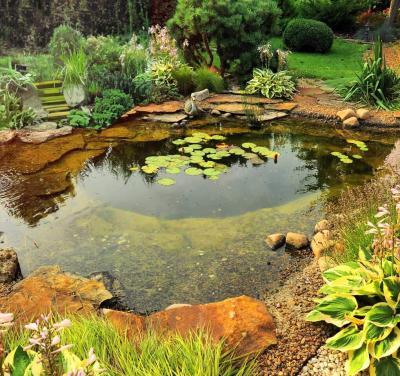In the ever-changing seasonal landscape of Central New York, ponds serve as serene oases for both wildlife and property owners. As the seasons shift, one often overlooked aspect of pond maintenance comes into sharp focus: proper pond depth. This element plays a vital role in the health and sustainability of your aquatic ecosystem throughout the year. But why should you maintain the right pond depth throughout the seasons? And how does it impact your ponds aquatic ecosystem?
Why Proper Pond Depth is so Important
Proper pond depth is not a one-size-fits-all concept. It varies depending on factors such as the pond’s purpose, local climate, and the types of fish and plants you want to cultivate. In Central New York, where we experience distinct seasonal changes, a well-designed pond typically includes areas of different depths to accommodate various needs throughout the year.
Generally, a pond should have shallow areas around the edges, gradually sloping to deeper sections. The deepest part of the pond should be at least 3 to 4 feet for most ornamental ponds, while ponds intended for fish like koi may require depths of 6 feet or more in some areas. This variety in depth creates a more natural environment and supports a diverse ecosystem.
The Impact of Seasons on Pond Depth
 As the seasons change in Central New York, proper pond depth becomes increasingly important. Each season brings unique challenges and requirements for your pond ecosystem.
As the seasons change in Central New York, proper pond depth becomes increasingly important. Each season brings unique challenges and requirements for your pond ecosystem.
In spring, as the ice melts and rains increase, proper depth helps manage water levels and prevents overflow. The deeper areas of your pond provide a stable environment for fish emerging from winter dormancy, while shallower edges allow for new plant growth.
Summer brings warmer temperatures and increased evaporation. Deeper sections of your pond act as cooler refuges for fish, helping them escape the heat of the day. These areas also maintain more stable water temperatures, reducing stress on your pond’s inhabitants.
As autumn approaches, proper pond depth ensures there’s enough water volume to buffer against falling leaves and organic matter. This helps maintain water quality as decomposition increases.
Winter in Central New York can be harsh, and proper pond depth is critical for fish survival. Deeper areas are less likely to freeze solid, providing a safe haven for fish during the coldest months.
Benefits of Proper Pond Depth for Aquatic Life
Maintaining the right pond depth is essential for supporting a thriving ecosystem. Fish, plants, and beneficial microorganisms all depend on proper depth to flourish.
For fish, varying depths provide different environments for feeding, breeding, and shelter. Deeper areas offer safety from predators and temperature extremes, while shallower regions support spawning and young fish development.
Aquatic plants also benefit from a range of depths. Marginal plants thrive in shallow areas, while submerged plants prefer deeper waters. This diversity in plant life not only enhances the pond’s beauty but also contributes to better water quality and provides natural filtration.
Proper depth also supports beneficial bacteria and other microorganisms that are essential for maintaining the pond’s ecological balance. These tiny helpers break down organic matter and help keep your pond clean and healthy.
Maintaining Water Quality Through Proper Depth
One of the most significant benefits of proper pond depth is its impact on water quality. Deeper ponds generally have more stable water chemistry and temperature, which is beneficial for all pond inhabitants.
A well-designed pond with proper depth helps prevent issues like algae overgrowth. Deeper water allows less light penetration, reducing the likelihood of excessive algae formation. Additionally, the increased water volume in deeper ponds dilutes nutrients, making it harder for algae to thrive.
Proper depth also aids in oxygenation. While surface area is important for oxygen exchange, depth plays a role in circulation and distribution of oxygen throughout the pond. This is particularly important during summer when warm water holds less dissolved oxygen.
Adapting and Maintaining Proper Pond Depth
Achieving and maintaining proper pond depth requires ongoing attention and occasional intervention. As seasons change, you may need to adjust your pond management strategies.
Regular depth measurements, especially after heavy rains or prolonged dry spells, can help you stay on top of any changes. If you notice areas of your pond becoming too shallow due to sediment buildup, consider removing excess material to restore proper depth.
In times of drought, you may need to add water to maintain appropriate levels. Conversely, having a plan for excess water management during heavy rains is equally important.
Consider installing an aerator or fountain to improve circulation and oxygenation, particularly in deeper areas of your pond. These additions can help maintain water quality and support aquatic life, especially during challenging seasonal transitions.
As winter approaches, ensure that your pond has sufficient depth to prevent complete freezing. If necessary, use a de-icer to maintain an opening in the ice for gas exchange.
In conclusion, proper pond depth is a fundamental aspect of pond health and maintenance that changes in importance as seasons shift. By understanding and managing the depth of your pond, you create a more resilient and vibrant aquatic ecosystem that can thrive year-round in Central New York’s variable climate. Whether you’re a seasoned pond owner or considering adding a water feature to your property, remember that depth matters. It’s not just about how your pond looks on the surface, but how it functions beneath to support life and maintain balance through every season.
